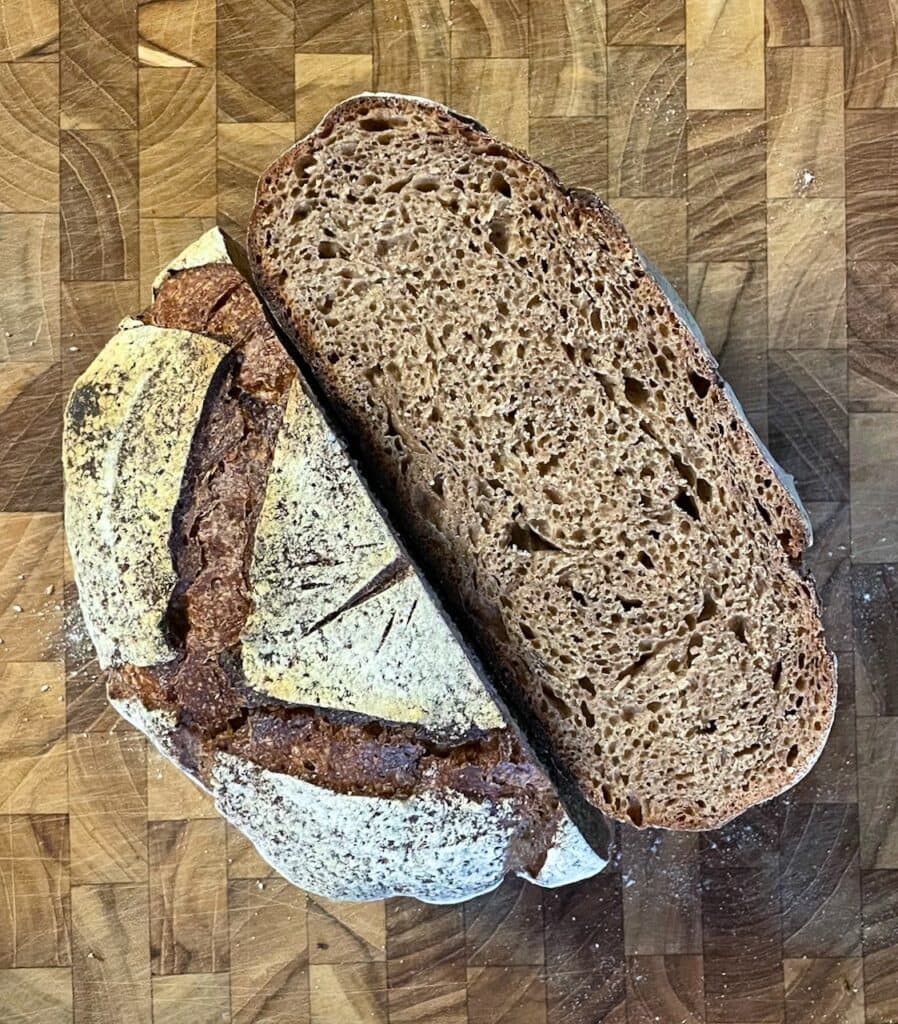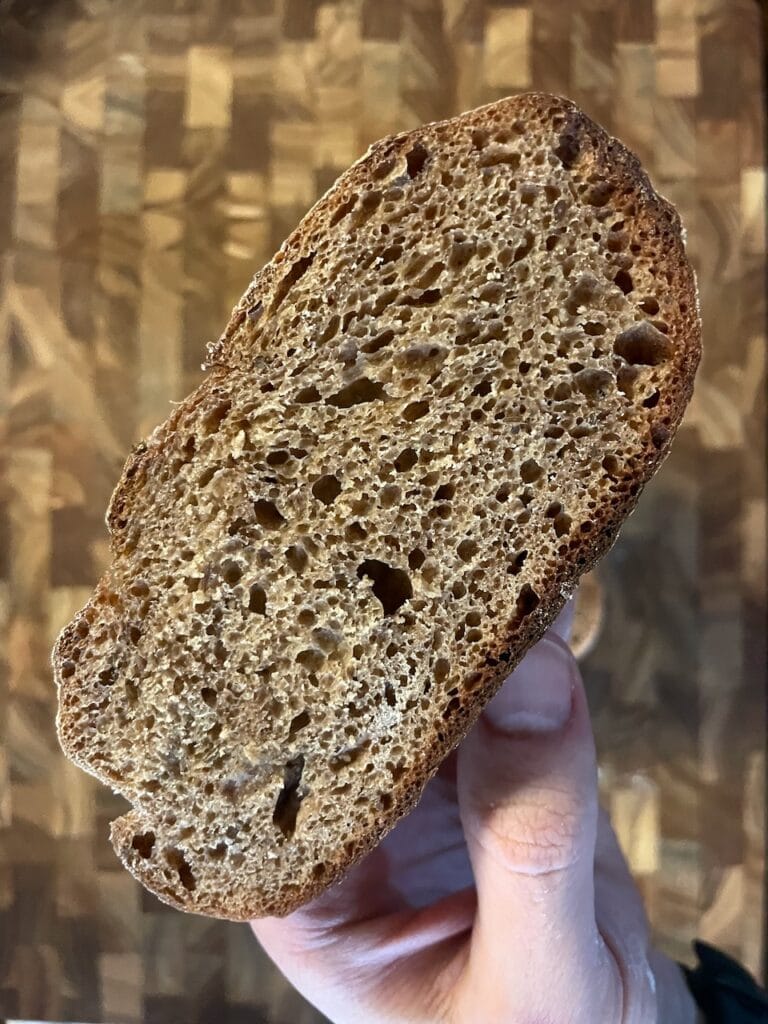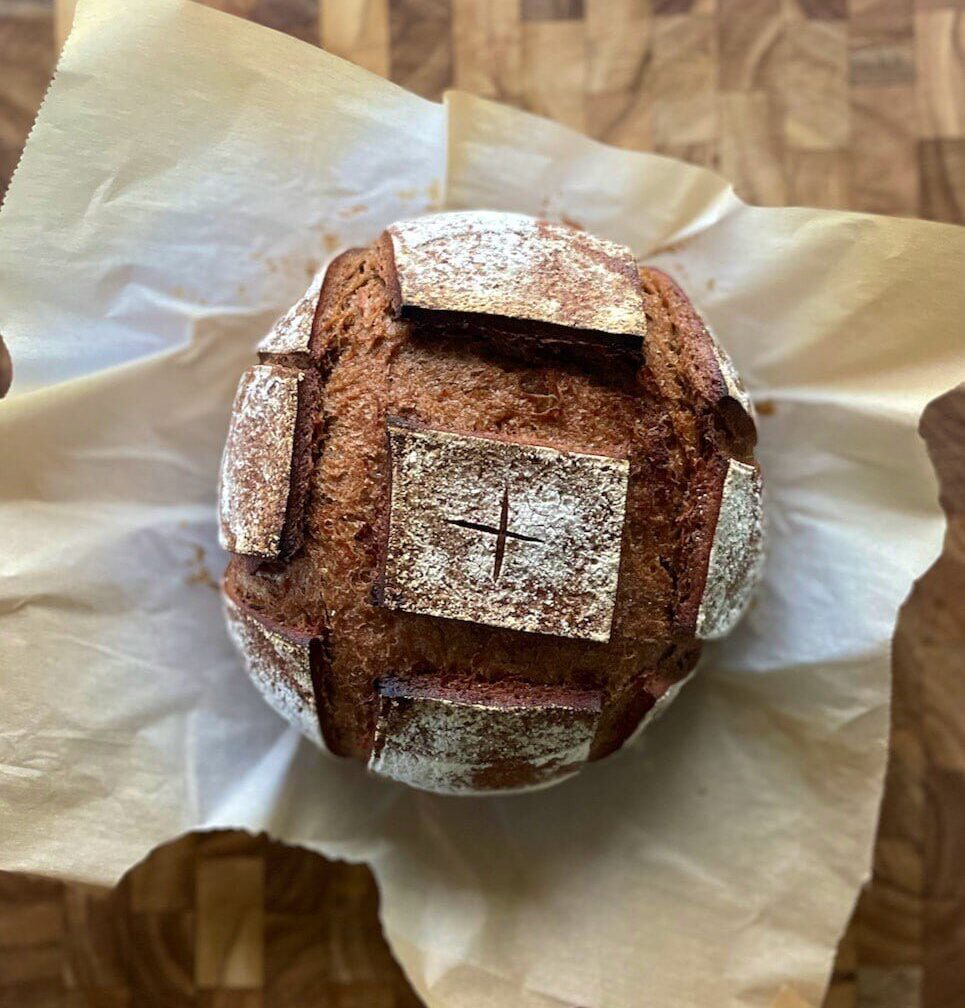Disclosure: this page may contain affiliate links, where I earn a commission (at no cost to you) if you decide to make a purchase. With that being said, I will only ever recommend products that I actually use and fully endorse.

Distinctive rye bread flavor, with a tangy sourdough leaven.
This loaf is fairly traditional in terms of rye bread. The signature “rye bread” flavor is from the caraway seeds, which give the expected notes of citrus and herb. The deep brown color, meanwhile, comes from the addition of molasses and cocoa powder. The contribution of the rye flour itself is not so much in the flavor or color, but rather the soft, moist, and chewy texture it has from the low gluten content. This version is also sourdough leavened, for the subtle tang that is expected from a loaf of rye bread.
Uses for this sourdough dark rye bread.
Consider toasting and topping with cream cheese and lox, serving with a hearty bowl of soup, or having alongside a selection of cheeses and wine. And, of course, it can make an incredible sandwich. Fill it with corned beef, Swiss cheese, sauerkraut, and Russian dressing for a classic rueben. Or keep it simple with pastrami and mustard. A grilled cheese or panini would be a delight, and so would a boldly-flavored tuna, chicken, or egg salad. Serve with a pickle and chips for the full deli experience.
For some suggested recipes to pair with this bread, check out my Salmon Cream Cheese with Dill, Ricotta and Goat Cheese Bread Bowl Dip, and Summer Shrimp and Corn Chowder.
The no-knead method of bread making.
The no-knead method allows you to create stunning loaves at home, without the labor-intensive kneading that is usually required. By just mixing the ingredients and letting them sit, the gluten will develop naturally over time. This also allows plenty of time for sourdough flavor to evolve. The no-knead method used in this recipe is based on the one developed by Jim Lahey of the Sullivan Street Bakery in New York (for more no-knead recipes, check out his books here).
Although this method does take longer, there is little hands-on activity and it is easily fit into a busy schedule. I like to start the night before I plan to bake. On that night I will mix the ingredients and then let them sit overnight to rise and develop gluten. In the morning I shape the dough into a loaf and throw it in the fridge. In the evening (or the next morning, if you prefer), the loaf is ready to bake.
If you are new to sourdough—or bread making in general—no-knead bread is a great place to start. And don’t get discouraged if your loaves are not perfect at first. This is a skill that, like any, requires practice. Once you get the hang of it you’ll be enjoying bakery-style loaves without having to leave the house.
For another no-knead sourdough recipe, check out my 50% whole wheat sourdough.
Equipment and Ingredients
This sourdough dark rye bread bakes in a Dutch oven to create the perfect crispy crust, so make sure you have one on hand. If you are shopping for a Dutch oven, take a look at Nest Homeware. They are offer a 3.5 qt cast iron Dutch oven that is both beautiful and highly functional. It is a great size for making loaves and is the one you will see in the pictures for this recipe. If you don’t have a Dutch oven, you can experiment with baking on a pizza stone, with a pan of boiling water in the oven.
This recipe also requires active sourdough starter. This means your starter should at least double 12 hours after being fed, and be used within 24 hours of feeding. Your starter may require more than one feeding prior to baking, so plan ahead.
Otherwise, it does not require any special equipment. Certain equipment may be helpful though. I highly recommend a kitchen scale for accurate measurements. Volumetric measurements are provided in this recipe, but be sure to sift and level appropriately for best results. Other tools you may find helpful are a proofing basket, bench scraper, and lame (a razor for scoring the bread). A quality serrated knife is also helpful when it comes time to cut the finished loaf. If you do not have one, the bread can be torn apart with your hands. This works best if you are serving it with soup or a saucy meal.


No-Knead Sourdough Dark Rye Bread
Ingredients
- 21 grams (1 tbsp) molasses
- 270 grams (1 cup plus 2 tbsp) water
- 25 grams (2½ tsp) sourdough starter active/fed
- 284 grams (2 cups) bread flour
- 106 grams (1 cup) dark rye flour
- 8 grams (1⅓ tsp) fine salt
- 5 grams (1 tbsp) unsweetened cocoa powder
- 6 grams (2 tsp) caraway seeds
- Ice cube for baking
Instructions
- In a medium bowl whisk together molasses and water until molasses has dissolved. Add starter and whisk until dissolved.
- In a large bowl whisk together flours, salt, cocoa powder, and caraway seeds. Add wet ingredient mixture to dry ingredients and mix just until a shaggy dough forms. Cover with a towel and let sit for 20-30 minutes.
- Wet your hands and gently fold the sides of the dough into the middle. The dough should become smoother and less shaggy looking. Transfer dough to a clear container or bowl. Mark the position of the top of the dough on the side the container with a washable maker or rubber band cover with plastic wrap or a towel.
- Leave dough to rise at room temperature until it has doubled in volume. This may take around 6-12 hours but this depends on the ambient temperature and the strength of your starter. For faster rising, or if room temperature is below 70°, proof in the oven with the light on (and leave yourself a sticky note on the oven so you don’t forget it is in there).
- Line a proofing basket (or 8 to 9-inch bowl or colander) with a towel and dust with flour.
- Fill a small bowl with water and use it to wet your hands. Gently release dough from the sides of the container and transfer to a wet or lightly floured work surface. Lightly stretch the dough into a rough square about 7×7-inches. Wet hands and again fold each corner into the middle. Repeat again, folding the corners into the middle. Continue until the dough becomes a somewhat taut ball. Transfer to prepared proofing basket seem-side up. Pinch the seems closed and dust the exposed side of the dough with flour.
- Cover dough with a towel and transfer to the fridge. Allow dough to cold proof in the fridge for 12-24 hours. Alternatively, proof at room temperature for 2-4 hours, or until dough has about doubled in volume.
- An hour before you plan to bake place a Dutch oven or deep skillet with lid in the oven and preheat to 450°. Once oven has preheated for an hour remove your dough from the fridge. Carefully flip your dough onto a sheet of parchment paper seem side down. Score the top of the loaf about 1/4-inch deep with a serrated knife or razor blade. The scoring can be a single slash down the middle, a cross, a square, or any pattern you like.
- Remove preheated Dutch oven from the oven and carefully lower dough into the pot. Add an ice cube to the pot and cover. Bake for 20 minutes then remove lid and bake for an additional 15-20 minutes until browned and internal temperature of about 210°.
- Remove to a wire rack to cool completely, at least an hour, before cutting (or tearing) into your bread.


I used beer instead of water, left in fridge over night (24 hours}, plopped into proofing basket next day, let it rest at room temp while oven heated up and didn’t use ice cube. I had to add about 20 minutes cooking time due to altitude and cured/rested/cooled for 48 hours in cold oven. Best tasting and looking loaf of bread I ever made. Now if I could scale it up, I’d be rich I tell you.
Sounds awesome, I gotta try it with beer!